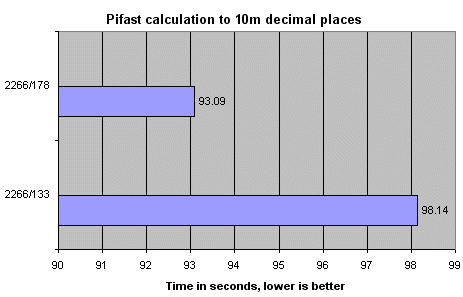Benchmarks I
|
We'll start of with Sisoft Sandra's memory benchmark, one that highlights streaming data performance. This benchmark is only indicative of potential bandwidth.
We see that keeping the CPU speed constant but increasing the memory bandwidth to 178MHz (DDR356) from the standard 133MHz (DDR266) pays dividends in this benchmark. Remember, all you have to do to be able to run at the faster memory speed is firstly have RAM capable of sustaining the faster speed, and secondly, set the DRAM Ratio H/W Strap to low in BIOS. A 20% increase in memory throughput, albeit in a synthetic benchmark, is pleasing. Greater bandwidth usually leads to increased performance in most applications. Let's see how the bandwidth affects our first practical benchmark, Pifast. Put simply, it calculates the constant Pi to x number of places. It requires an efficient memory controller for decent performance.
I've used this benchmark many times before and have never found such a difference between results when the only variable that has been changed is the memory speed. Just switching from RAM running at 133MHz to 178MHz, whilst the CPU is held constant, gives us a 5 second advantage. This just goes to that at relatively high clock speeds, the P4 just craves bandwidth. |











